INTERESTING REMINDER: Someone sent us this old photograph, as it speaks to a problem that the technology industry has caused in our country today, that of texting and driving. Yes, we assume, the arrival of the automobile and the typewriter could have caused similar problems. This is a good reminder to us today!
IN THIS EDITIONEditor’s Note: There will be no Friday edition of GwinnettForum this week. The next issue will be published on Tuesday, May 3. — eeb
TODAY’S FOCUS: What Drives the Artists to Keep “Taking a Licking” from Viewers?
EEB PERSPECTIVE: What One Organization Faces After 57 Years of Operations
SPOTLIGHT: Gwinnett Village Community Improvement District
FEEDBACK: Idea of a Bridge Across 141 Has Awakened Peachtree Corners as Issue
UPCOMING: County Buys New Devices to Help in Cardiac Arrest Cases
NOTABLE: GACS Announces New Roles for Four Veteran Educators
GEORGIA TIDBIT: World’s First Black Combat Aviator Was Born in Stewart County
TODAY’S QUOTE: What Doing Good in the United States Has Become
MYSTERY PHOTO: Several Clues in This Round-About May Lead You to Solution
LAGNIAPPE: Rotary Honors Connie Wiggins for Her Extensive Service to Gwinnett
TODAY’S FOCUSWhat drives the artists to keep “taking a licking” from viewers?
By Karen Burnette Garner
DACULA, Ga., April 26, 2016 | I may be showing my age, but remember the old Timex watch commercial? To display the fine workmanship and durability of the watch, the spots showcased examples of the Timex being abused in many ways, and at the end, it was always still working! The message was the product was built tough, built to last, and was a good investment (though they were, and are, very affordable.) As an artist myself, may I ask, what do we do to make our work, and ourselves, able to “take a licking and keep on ticking?”
When creative people put the results of their creativity out for public display, that same public always has a reaction. It might be ridicule, astonishment, offense, acceptance, adoration, or neglect, among a million others.
Of course, we want the better of those choices, and a financial reward would be a nice touch, too, right? What if nothing happens? Egos take a beating, and we are left shaking our heads, wondering what we did that brought the hounds to our heels, or worse yet, that no one even noticed!
At the end of the day, each artist must face the real reason we do what we do: it feeds us, it calms us, it shares our message, it is an avenue to vent our views, or maybe it is an attempt to connect to a wider world. Our motivations are as unique as each of us.
What drives the artist to keep “taking a licking?”
For me, I know it is a drive that I cannot deny, a way to leave some of myself and my view of the world for others to explore. Who knows who will be inspired by my work? I know that I have been inspired by other artists, literary and visual, musical and intellectual.

Here’s a sample of Karen Garner’s work, often centered in the Lowcountry. This one is entitled “Still waters.” To see more of her works, visit www.karenburnettegarner.com.
Recently, one of my inspirational teachers, Pat Conroy, passed away. I was deeply affected. I had met him several times, mostly when he was living in Atlanta, but I’ve loved his writings (sometimes struggling with the demons he released through those cathartic stories), and he taught me to love the Lowcountry, the coastal plain that fills and empties brackish water twice a day.
His descriptors were so rich and fragrant, you could almost taste them. I don’t know that I would have ever connected so strongly to this region down the road if I had not read his work. Something in writing from his heart spoke to mine, and I will be forever grateful for that. I am sure in his writing life, he took some hits, as well as his personal life. He was at war with his home city and his military academy, The Citadel, for many years for exposing some of the dirty laundry that others would have preferred stay hidden. In the end, he made peace with them, or they with him, and he died a loved, and greatly missed native son. What a legacy!
What are you, as an artist, or in any other profession, doing to inspire others, and “keep on ticking?” What will it take for you to see that your influence on those who surround you, casually or closely, touches their lives with the paintbrush (or hammer, or pen or your computer skills) you hold? Or the chisel you wield? Or the story you write?
Bravely face what your art (or your work) brings you, continue to put yourself out there, if for no other reason than to prove to yourself that you have a voice among the many. Even if you take a licking….keep on ticking.
EEB PERSPECTIVEWhat one organization faces after 57 years of operations
By Elliott Brack, editor and publisher
APRIL 26, 2016 | Take any large organization you can imagine. Let’s say that this activity has been going on for 57 years. What would you think the organizatio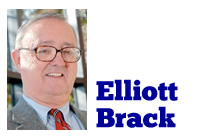 n would be like?
n would be like?
Would it surprise you to think that among its millions of people, that some sort of informal internal structure would have developed? That structure would be the day-to-day way this group worked, the mechanism for insuring that the organization was performing as it should. Perhaps we could even use the word “Bureaucracy” in describing how it worked.
Remember, this organization is 57 years old. By now people originally there have long retired, or even died. We are into a second, third and perhaps even fourth generation of key people in keeping this organization running.
Now think too: what if what is being described was a government of a country, for instance, Cuba? And what if its objectives were not always going well? You would think that in a Communist country, centrally run, like Cuba and its 11 million people, its leaders could click their fingers and see major changes, right?
Wrong!
We got that idea from a speech made by President Raul Castro recently in a two-hour appearance before the Cuban Communist Party. It meets only twice a decade, which says something in itself about its slowness to develop.
Five years ago, President Castro announced that Cuba would change. He had proposed 313 “guidelines” to stimulate what is essentially a stagnant economy, one entirely controlled by the Communist Party itself.
Guess what? Castro, citing a statistic from his own government, said that only 21 percent of the “guidelines” he suggested in 2011 have been carried out.
Can you imagine the cause?
Here are Castro’s own words addressing this problem: “The obstacle that we’ve confronted, just as we expected, is the weight of an obsolete mentality that takes the form of an attitude of inertia.”
Another way to say that: “Cuba’s bureaucrats.”
It’s true that all large organizations have bureaucrats. They often run the routine activities of any big corporation, non-profit, or government. Change always threatens them, their jobs, their livelihood, their families. Would they seek to deny change? Surely they would. In doing so, it might hold their country back. But it would protect them and their cronies.
It doesn’t matter to these officials if the country of Cuba has severe economy problems, if food is rationed and often scarce, if living conditions are not up to a par with some third world countries? After all, these bureaucrats are in a solid, secure position. They barely feel it.
 You can see the problems that President Castro is confronting. While the leaders of the country (and party) might want improvement and change, they are fighting an internal battle. And it may mean that the change Americans have hoped for in Cuba, in a softening of relations from the top, may be torpedoed by the underbelly of a bureaucratic government.
You can see the problems that President Castro is confronting. While the leaders of the country (and party) might want improvement and change, they are fighting an internal battle. And it may mean that the change Americans have hoped for in Cuba, in a softening of relations from the top, may be torpedoed by the underbelly of a bureaucratic government.
Cuba has made major strides in its Communist regime in two key areas: education and medicine. Education is free for all, while its universities, using up-to-date methods, train many of the skilled medical professionals for South and Central America.
But what of raising the Cuban standard of living, having sufficient foods, eliminating poverty and letting its people be free? Cuba still lags in these areas. It may take years to see improvements here.
The Castro years will end soon, with Fidel now 90 and Raul 84. What will come next?
One more thought: Is Cuba’s bureaucracy much different from that of the USA?
Gwinnett Village Community Improvement District
The public spiritedness of our sponsors allows us to bring GwinnettForum.com to you at no cost to readers. The Gwinnett Village Community Improvement District was formed in 2006, and is a self taxing revitalization district that includes just over 800 commercial propert y owners with a property value of over $1 billion dollars. Gwinnett Village CID includes the southwestern part of Gwinnett County including properties along Jimmy Carter Boulevard, Buford Highway, Indian Trail, Beaver Ruin, and Singleton Road. Gwinnett Village is one of four CIDs to be created in Gwinnett County and is the largest of all CIDs in the state. Gwinnett Village’s mission is to improve property values through increased security, a decrease in traffic congestion, and general improvements to the curb appeal of the area.
y owners with a property value of over $1 billion dollars. Gwinnett Village CID includes the southwestern part of Gwinnett County including properties along Jimmy Carter Boulevard, Buford Highway, Indian Trail, Beaver Ruin, and Singleton Road. Gwinnett Village is one of four CIDs to be created in Gwinnett County and is the largest of all CIDs in the state. Gwinnett Village’s mission is to improve property values through increased security, a decrease in traffic congestion, and general improvements to the curb appeal of the area.
- For more information visit www.gwinnettvillage.com or call 770-449-6542.
- For a list of other sponsors of this forum, go to: Our sponsors.
Idea of a bridge across 141 has awakened Peachtree Corners as issue
Editor, the Forum:
![]() It seems that this bridge issue in Peachtree Corners has awakened a community that had been basically ignoring what the new city-lite was doing. Less than 2,000 voted in the issues posed for the city.
It seems that this bridge issue in Peachtree Corners has awakened a community that had been basically ignoring what the new city-lite was doing. Less than 2,000 voted in the issues posed for the city.
Now the community is activated in opposition to this grandiose bridge project that may well be a white elephant. It may have people wondering whether city-lite is so lite or what they want at all. Only 7,000+ voters total determined that it was to exist with 4,000+ saying yes.
The city lite election was won by a motivated minority, but lost by those who did not take it seriously or weren’t paying attention. Now people are starting to pay attention because we are talking about millions of dollars and silly projects.
— Byron Gilbert, Peachtree Corners
- Send Feedback and Letters to: elliott@brack.net
County buys new devices to help in cardiac arrest cases
The Gwinnett County Board of Commissioners have approved the purchase of the LUCAS devices, equipment that delivers consistent and uninterrupted chest compressions to patients experiencing sudden cardiac arrest emergencies. Medical professionals use the device during the performance of CPR.
![]() The Department of Fire and Emergency Services will purchase 31 LUCAS devices from Physio-Control Inc. The equipment comes at a total cost of $593,834.68 and includes batteries, disposable supplies and maintenance.
The Department of Fire and Emergency Services will purchase 31 LUCAS devices from Physio-Control Inc. The equipment comes at a total cost of $593,834.68 and includes batteries, disposable supplies and maintenance.
Fire Chief Casey Snyder said, “The placement of the LUCAS device on every first-out ambulance will allow our personnel to continue providing exceptional pre-hospital emergency medical care to residents and visitors.”
The American Heart Association recommends that a patient in cardiac arrest receive artificial chest compressions at a rate of 100 to 120 times per minute at a depth of 2 to 2.4 inches, with as few pauses as possible. Paramedics are often met with situations that cause interruptions to quality chest compressions lasting longer than 10 seconds. Such situations occur when a patient is being moved down a flight of stairs, while moving through narrow hallways or doorways, or when first responders are unable to access the patient’s side. The LUCAS device delivers continuous chest compressions at a rate and quality necessary to provide the greatest chance of survival for patients and will aid paramedics in getting the patient to the ambulance or transport vehicle without interrupting care.
Added Snyder, “Use of the device will eliminate the need for extra resources to be deployed on cardiac related calls, freeing up emergency personnel for other responses.”
Gwinnett Ballet Theatre offers dance instruction this summer
Gwinnett Ballet Theatre (GBT), the county’s oldest non-profit performing arts organization, announces its programs for summer, offering the highest quality dance instruction for ages 3 to 18.
Summer camps for young dancers, ballet intensives for all levels, open classes and a special series of open house events begin May 30 and continue until school starts August 8. All programs are held in GBT’s spacious 22, 000 square foot studios located at 1800 Macleod Drive in Lawrenceville, just across Sugarloaf Parkway from Gwinnett Tech off Georgia Highway 316.
Summer camps for 3-5 years old features dancing and creative movement, crafts, costumes, and more. These camps will be offered June 6-10 and July 18-22 from 10 a.m. until noon.
For the young dancer looking to maintain and advance their skills during the summer, there are two intensives. For young artists age 6 and up just beginning ballet, there will be a Beginner Program intensive, and for those who have been taking dance longer but are not yet considered “advanced,” there is an Intermediate Program. Both are June 6-10 and July 18-22 and are held from 10 a.m. until 2 p.m.
Advanced dancers will have the opportunity to be taught by Robert Dekkers, founder and choreographer of San Francisco’s “Post:Ballet” during GBT’s Advanced Intensive held May 30 – June 3. This intensive will be from 10 a.m. until 4 p.m.
Reservations should be made as soon as possible. Call 770-237-0046 for reservations and pricing information.
Open Classes are a favorite feature of GBT’s summer. Beginning the week of May 30 and going through August 5 with the exception of the week of July 4, these open classes offer a flexible schedule where dancers can take ballet class from one of GBT’s excellent, professional teaching staff who will teach on a rotating basis, allowing students to benefit from several different teachers. Classes will be held on Monday, Wednesday, and Friday from 4 – 6 p.m. and cost $20 per class. There is no commitment for any number of classes; students may come as classes fit their schedules.
Open Houses are an excellent way for potential students to get acquainted with GBT, featuring tours of the spacious facilities, meet the staff, refreshments, and other activities. The first Open House will be Sunday, May 15 from noon until 4 p.m. On this date, visitors can peek in during GBT’s Mandatory Placement Classes for its beginning, intermediate and advanced students starting at noon and continuing throughout the afternoon. GBT will schedule more Open Houses and activities as the summer progresses.
- For more information call 770-237-0046, write gbt78@bellsouth.net or visit the web site at www.gwinnettballet.org.
City of Lilburn Relay rally will be April 29 at Lilburn City Park
The Lilburn Relay for Life Rally returns to Lilburn City Park on Friday, April 29 at 5 p.m. Sponsored by the Lilburn Woman’s Club, this event is a fundraiser for the American Cancer Society’s Gwinnett Relay for Life.
Participant registration for the rally is free. Sweetwater Masonic Lodge members will be grilling, and teams will have snacks and drinks for sale as their fundraiser. Additionally, there will be several prizes for participants; best decorated tent, team with the most members, most money raised by a team, and most money raised by an individual participant.
Survivors will be honored at 5 p.m. in City Hall where a complimentary light meal will be served. Music on Main Street will provide the entertainment. Boulder Monkey and Crying Room Players will be performing all evening.
- To be a part of this event, go to http://tinyurl.com/lilburnrelayrally. For more information: Contact Pat Swan at sbp6388@aol.com or Gail Zarnik at gailz18@aol.com.
A cookout fundraiser for the rally will be held at the Lilburn City Park Pavilion Wednesday, April 27, serving hot dogs and hamburgers starting at 11:15 a.m.
Sidewalks, intersection improvements coming in three areas
Gwinnett Commissioners have approved close to $2.8 million in transportation contracts to build four sections of sidewalk and two intersection improvements. Funding comes from SPLOST funds.
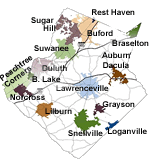 Commissioners approved the low bid of $493,644 by Peach State Construction to install sidewalks in southern Gwinnett County. The sidewalks will run along the east side of Bethany Church Road from U.S. Highway 78 to Overland Trail. Sidewalks will also be added along the east side of Killian Hill Road for 630 feet. Additionally, curb and gutter and drainage improvements will be constructed. These two projects total just over a half mile of sidewalk.
Commissioners approved the low bid of $493,644 by Peach State Construction to install sidewalks in southern Gwinnett County. The sidewalks will run along the east side of Bethany Church Road from U.S. Highway 78 to Overland Trail. Sidewalks will also be added along the east side of Killian Hill Road for 630 feet. Additionally, curb and gutter and drainage improvements will be constructed. These two projects total just over a half mile of sidewalk.
Commissioners also awarded a contract for $609,654 to low bidder CMES to build sidewalks along Lee Road and Telida Trail, also in southern Gwinnett. Along with 0.65 miles of sidewalk, curb and gutter and drainage improvements will also be made.
CMES was the low bidder as well on intersection improvements at Georgia Highway 124/Braselton Highway at Mount Moriah Road and Hamilton Mill Road at Old Hamilton Mill Road. The award of $1,690,389 calls for the contractor to add a traffic signal along with left-turn lanes and an eastbound right-turn lane on Route 124/Braselton Highway at Mount Moriah Road. The Hamilton Mill Road at Old Hamilton Mill Road project will upgrade the intersection and add an eastbound right-turn lane on Hamilton Mill Road. Both projects also include curb and gutter and drainage improvements.
NOTABLEGACS announces new roles for four veteran educators
Executive changes at Greater Atlanta Christian School have been announced. The new roles were announced by Dr. David Fincher, president of the institution.
Scott Harsh, previously its senior high principal, will become GACS new academic vice president, assuming duties over the entire K-12 program. He has been with GACS for 20 years.
Harsh is a graduate of Harding University; has a master’s degree from the University of Georgia; an Ed. S. degree from Georgia State; and is currently pursuing his doctor’s degree from Abilene Christian University.
Assuming the role of senior high principal will be Charles Edwards, who was previously the senior high Dean of Students and Director of diversity for the private school. Edwards has his master’s plus an undergraduate degree from Vanderbilt University. He has been at GACS for six years.
Junior High Principal Brian Dollinger is taking on additional duties as the K-12 STEM advance officer. He has been at GACS for six years.
Dollinger is a graduate of Harding University, holds a master’s degree from Texas A&M University, and is currently finishing his doctoral degree from the University of Georgia.
Elementary Principal Dr. Brad Schultz is also now the chief innovation officer for the GACS campus. Dr. Fincher refers to him as “Mr. Creative,” known for his ability to advance substantial and engaging learning while keeping it fun.
He holds a bachelor’s degree from Freed-Hardeman University; a master’s degree and Ed. S. degree from North Georgia College and State University, and an Ed. D. from Georgia Southern University. He has been on the staff of GACS for 16 years.
Nominate someone for work in making historical records accessible
Do you know someone who has done outstanding work using, preserving, or making historical records more accessible? Think about the historical or genealogical society, library, museum, county or municipal government, researcher, local historian, educator or student. The Georgia Historical Records Advisory Council (GHRAC) wants to encourage and reward their efforts.
In 2003 GHRAC established the Archives Awards Program to recognize outstanding efforts in archives and records work in Georgia. By publicly recognizing excellent achievement, the Board strives to inspire others. Hundreds of organizations and individuals play a significant role in the preservation of our state’s documentary heritage.
GHRAC has 12 different award categories for individuals and organizations. Nominations may be submitted through June 1, 2016. Award recipients are honored by the GHRAC members at a ceremony during Archives Month in October. To nominate, visit Georgia Archives and click on Nomination Form where you can complete the nomination form and view previous award recipients. All nominations must be postmarked on or before June 1.
All of the following are eligible for an award. (You may nominate yourself or your own organization.)
- Local governments, courts, school systems, state agencies, and institutions
- Historical records repositories, historical societies, libraries, and museums;
- Educators, students, and researchers
- Legislators and government officials
- Individuals and organizations who support archives and records management
- Specialized subject societies in related fields such as oral history, genealogy, folklore, archaeology, business history, etc.
For more information, contact http://www.georgiaarchives.org/ghrac.
RECOMMENDEDAn invitation: what books, restaurants, movies or web sites have you enjoyed recently? Send us your recent selection, along with a short paragraph (100 words) as to why you liked this, plus what you plan to visit or read next. –eeb
GEORGIA ENCYCLOPEDIA TIDBITWorld’s first black combat aviator was born in Stewart County
Eugene Bullard was the world’s first black combat aviator, flying in French squadrons during World War I (1917-18). Before he became a pilot he served in the French infantry and was awarded the Croix de Guerre.
Born in 1895 in a three-room house in Columbus, Eugene James (Jacques) Bullard was the seventh child of Josephine Thomas and William O. Bullard. Bullard’s parents, married in Stewart County in 1882, had Creek Indian as well as African American ancestry. William Bullard was born into slavery on the property of Wiley Bullard, a planter in Stewart County. In the early 1890s William Bullard moved to Columbus, where he worked for W. C. Bradley, a rising cotton merchant.
The young Bullard attended the 28th Street School from 1901 to 1906. Although his education was minimal, he nonetheless learned to read, one of the keys to his later successes. With his older sister and brothers, Bullard absorbed his father’s conviction that African Americans must maintain dignity and self-respect in the face of the prejudice of a white majority determined to “keep blacks in their place” at the bottom of society. Shaken by the near lynching of his father in 1903 and seeking adventure in the world beyond Columbus, he ran away from home in 1906 at age 11.
In Atlanta he joined a group of gypsies (an English clan known by the surname Stanley) and traveled with them throughout rural Georgia, tending and learning to race their horses. The Stanleys brought to his attention that the racial color line did not exist in England. Disheartened that the gypsies were not soon returning home, Bullard left them at their camp in Bronwood in 1909 and found work and patronage with the Zachariah Turner family of Dawson.
Despite his relationship with the Turners, Bullard was still affronted by racism and he resolved to leave the United States for Great Britain. He did so as a stowaway on a German merchant ship which departed Norfolk, Va., on March 4, 1912, bound for Aberdeen, Scotland. In 1912-14, Bullard performed in a vaudeville troupe and earned money as a prizefighter in Great Britain and elsewhere in Western Europe. He appeared in Paris for the first time at a boxing match in November 1913.
At the beginning of World War I, Bullard joined the French army, serving in the Moroccan Division of the 170th Infantry Regiment. The French government awarded him the Croix de Guerre for his bravery at the Battle of Verdun. Twice wounded and declared unfit for infantry service, he requested assignment to flight training. He amassed a distinguished record in the air, flying 20 missions and downing at least one German plane.
Between the world wars he owned and managed nightclubs in the Montmartre section of Paris, where he emerged as a leading personality among such African American entertainers as Josephine Baker, Louis Armstrong, and Sidney Bechet. In 1923 he married Marcelle Straumann, the daughter of a wealthy Parisian family. The couple had two surviving children, Jacqueline and Lolita, before separating in 1931. In the late 1930s Bullard joined a French government counterintelligence network spying on Germans in Paris. When Nazi Germany conquered France in 1940 Bullard and his daughters escaped to New York City. He worked there in a variety of occupations for the rest of his life.
In 1959 French president Charles de Gaulle made Bullard a knight of the French Legion of Honor, the nation’s highest ranking order and decoration. Bullard died on October 12, 1961.
- To access the Georgia Encyclopedia online, go to http://www.georgiaencyclopedia.org
Several clues in this round-about may lead you to solution
A modern day round-about, a new model car, or a water fountain, may give you a clue to this issue’s Mystery Photo. Use your noggin to figure out this location and send it to elliott@brack.net and be sure to include your home city.
LAGNIAPPERotary honors Connie Wiggins for her extensive service to Gwinnett
Retiring Gwinnett Clean and Beautiful Executive Director Connie Wiggins was recognized by her home Rotary Club with a glass sculpture for her years of service to the county. President Marlon Allen and District, Lieutenant Tom Upchurch are shown with Ms. Wiggins and the award. Ms. Wiggins, who lives in Sugar Hill, was the first female president of the Gwinnett Rotary Club. She has been most active in many phases in Gwinnett County life. (Photo by Derek Peacock.)
CREDITSGwinnettForum is provided to you at no charge every Tuesday and Friday. If you would like to serve as an underwriter, click here to learn more:
- MORE: Contact Editor and Publisher Elliott Brack at: elliott@gwinnettforum.com




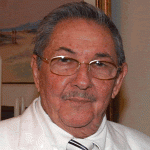


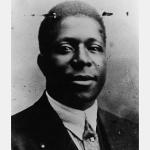
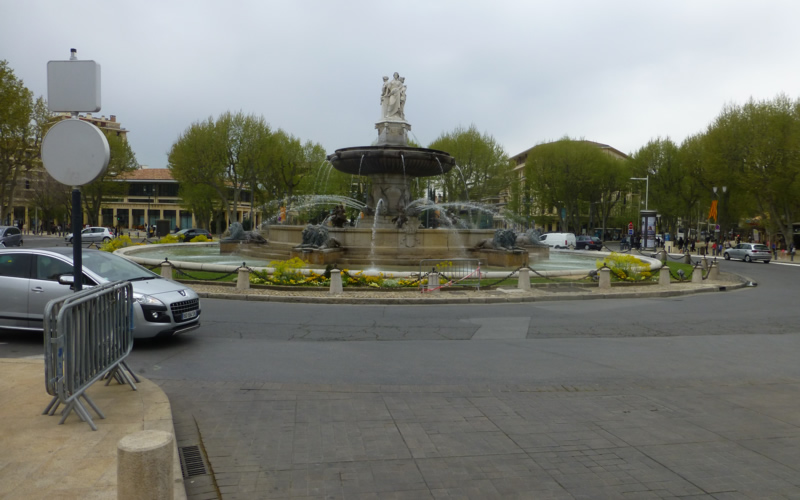
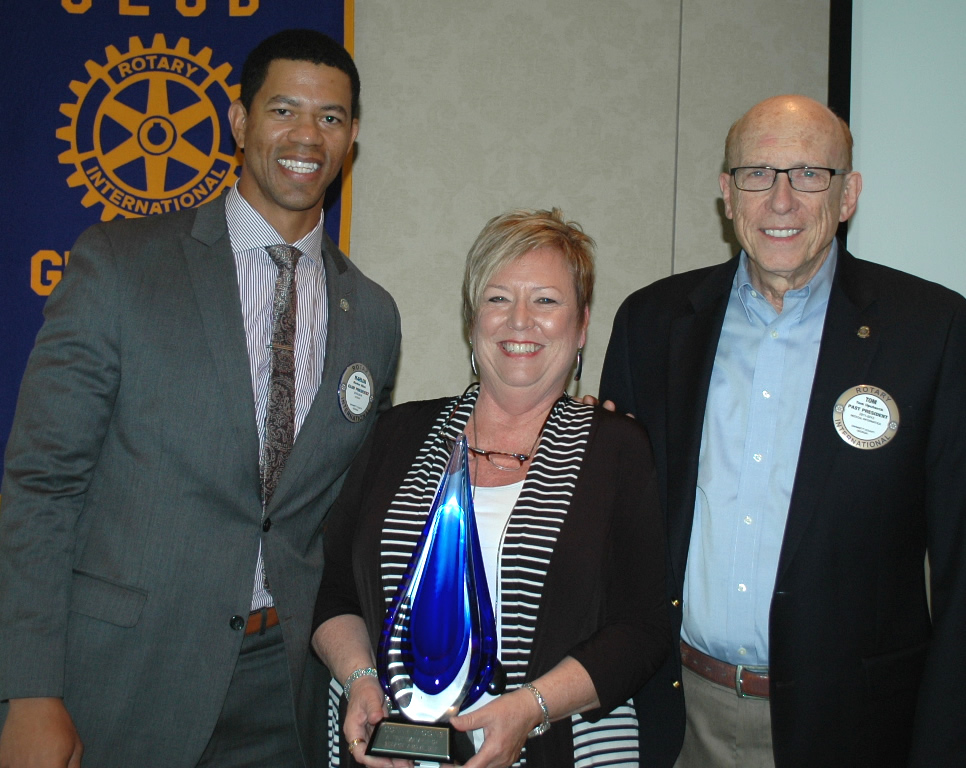







Follow Us